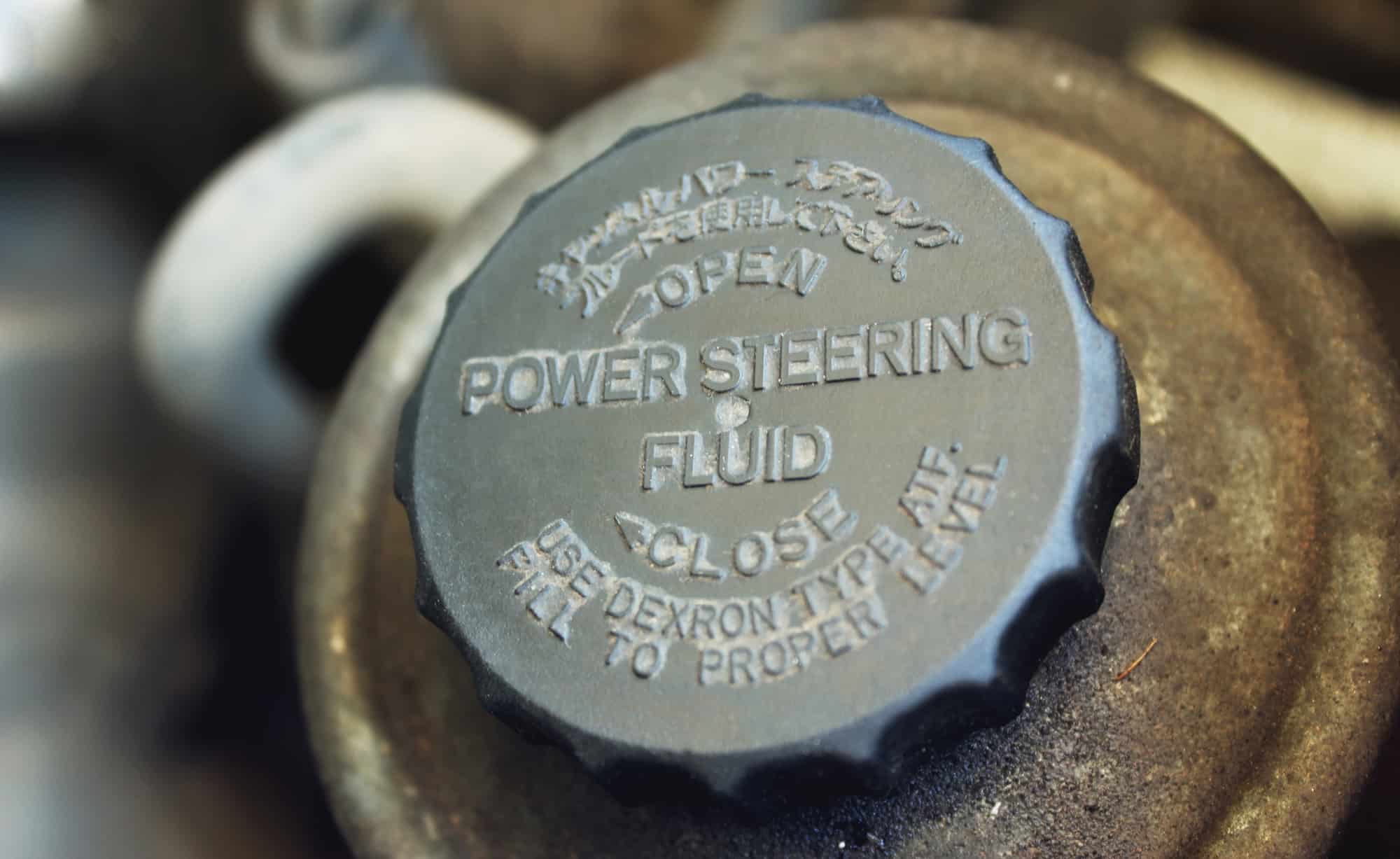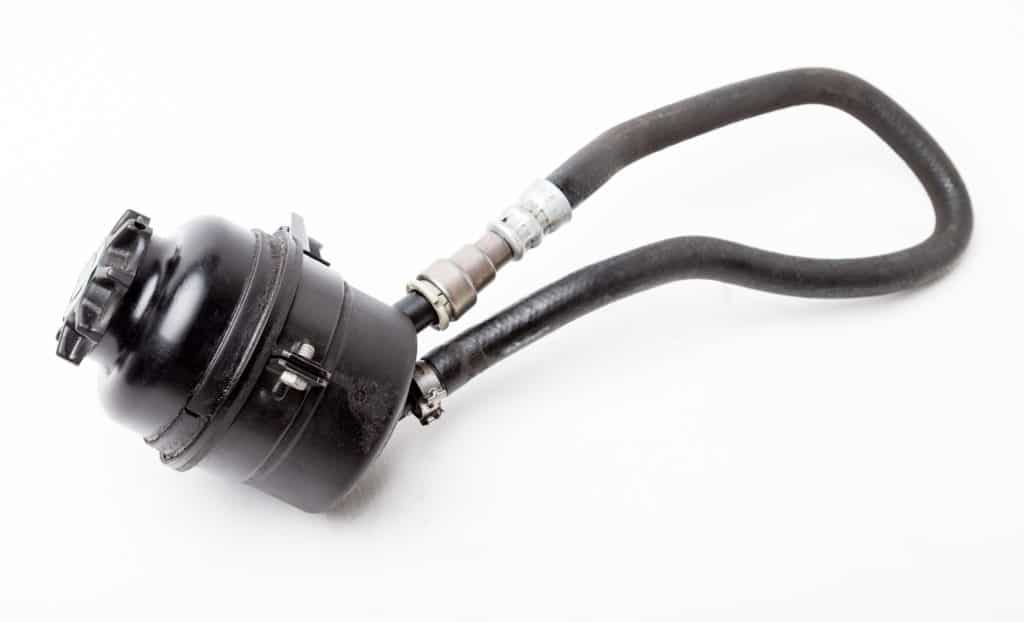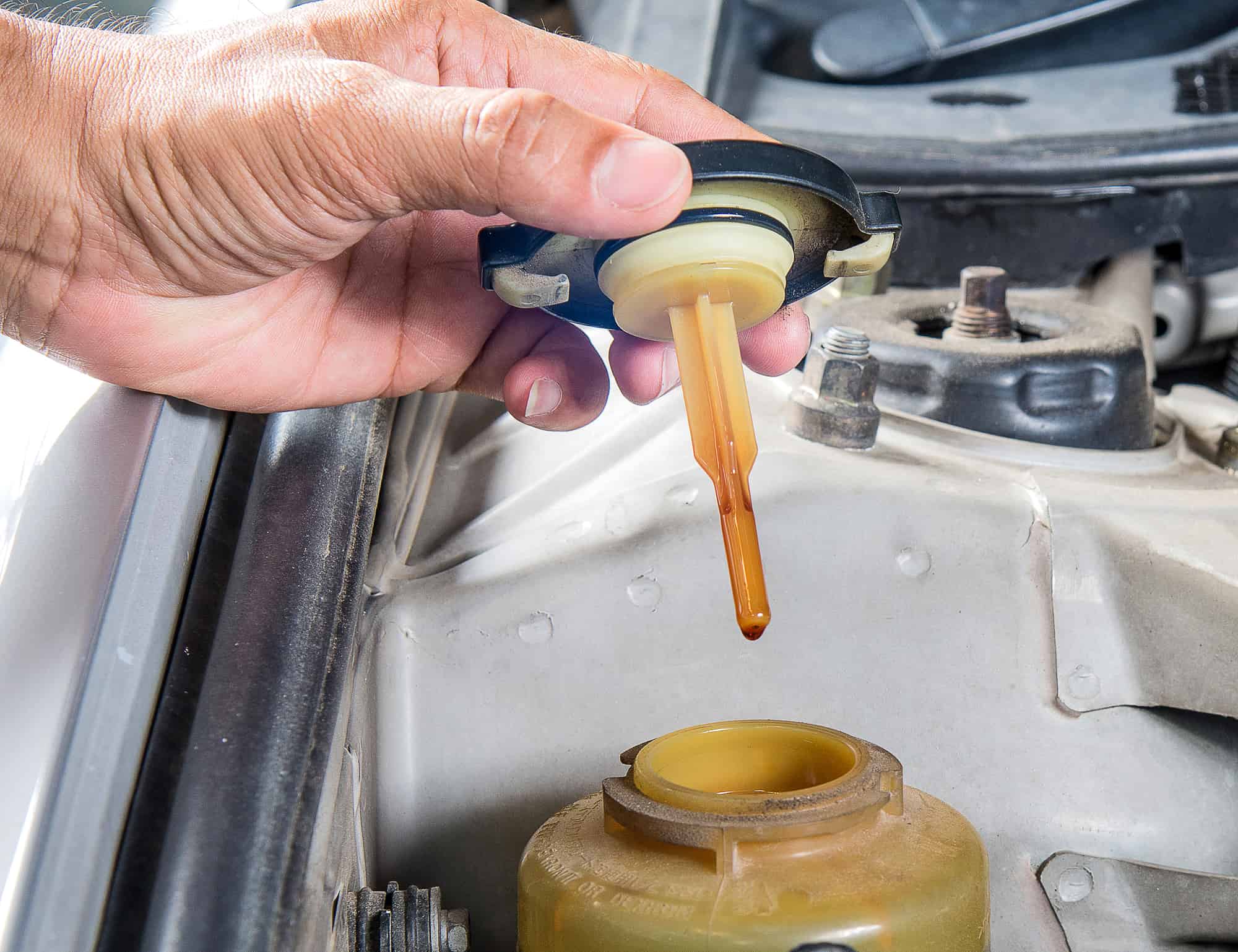A power steering fluid leak when the car is off can be caused by a damaged seal or a loose connection in the power steering system. Other possible causes include worn-out hoses a damaged power steering pump or faulty steering rack.
Leaks generally occur when the engine is running and the system is under pressure. However, it is possible for steering fluid to leak when the car is off.
If the power steering fluid is leaking when the engine is off you may notice a small deposit of dried fluid around the joints of some of the hoses, or the fluid in the power steering top up reservoir may continuously drop below the minimum recommended level.
As an Amazon Associate we earn from qualifying purchases.
What Causes A power steering Fluid leak When The Car is Off?
A power steering fluid leak that occurs when the car is off can be caused by a leaking power steering pump, a cracked power steering hose or a faulty steering rack.
The reason that the steering fluid will leak when the car is off is because when the engine is off the steering fluid rests in the system and is no longer under pressure. This can cause a negative pressure at the point of failure that sucks in air from the outside and this can push fluid out through a weak point in the system.
Here are the most common reasons for a power steering fluid leak when the car is off.
- The wrong power steering fluid is in the system
- Leaking power steering pump
- Failed power steering hoses and seals due to wear and tear
- Running the car with the wrong amount of power steering fluid
- Leaking power steering fluid reservoir
Cause 1. Using The Wrong Power Steering Fluid
Not all power steering systems use the same type of hydraulic fluid.
Some power steering systems use synthetic automatic transmission fluids (ATF), others use silicone-based fluids. The suitability of a fluid to a system is dependent on the type of power steering pump, what viscosity of fluid it can pump, and the materials used in the various hoses and joints of the system.

If you are topping up the power steering fluid, be sure not to mix synthetic fluid with silicone-based fluid, as this could cause a lot of damage to the hydraulic system.
Using the wrong fluid may leave the system open to rusting or the build up of dirt. Or it may even attack seals, plastic component or rubber parts, causing them to leak.
Cause 2. Leaking Power Steering Pump
If the power steering fluid drops below the minimum level, it’s going to put extra stress on all of the moving components.
Power steering pumps need an adequate supply of fluid to work, and they will wear out pretty quickly if they don’t get enough lubrication. Continuous usage of the pump under with a lack of fluid will wear the pump internal components, seals, and rubber parts.
The steering rack is also susceptible to extra wear and tear if it’s not getting a good supply of steering fluid.
Cause 3. Failed power steering hoses and seals due to wear and tear
High hydraulic pressures, normal usage, thermal fatigue, and environmental factors like humidity, heat, cold, and corrosion, will eventually wear out power steering components.
Seals and rubber components will often wear-out first. Leaks will inevitably appear once that happens.
However, a hydraulic power steering system is usually really durable. The lifespan of the hydraulic pump, rack, and seal can often be well over 100,000 miles depending on vehicle usage and weather conditions.
Cause 4. Running the car with the wrong amount of power steering fluid
Just like any other fluid in your car, you need to make sure that the correct amount of power steering fluid is in the system. Power steering fluid operates under pressure and it is the fluid that transfers the force from the power steering pump to the movement of the wheels.
If there isn’t enough fluid in the system then this will put extra pressure on the pump and on the steering rack that can cause premature failure. If there is too much fluid in the system then this will put extra pressure on the hoses and seals and this can lead to steering fluid leaks.
Cause 5. Leaking power steering fluid reservoir
The power steering fluid reservoir is another very common place for a power steering leak to occur. The reservoir usually has two rubber hoses attached, a feed hose and a return hose. It will also have a removable cap with an integrated dipstick for checking the fluid levels. Leaks will often occur at the hose joints or from the cap seal.
You can easily spot a leaking power steering reservoir as it will have dried, flaky fluid around the source of the leak.

What Next – How To Diagnose A Power Steering Fluid Leak When The Car Is Off
Diagnosing the power steering fluid leaks is far easier once you understand what causes those leaks. Below is a simplified procedure to effectively diagnose the system.
1. Check The power steering fluid condition
First thing you need to do is check the condition of the power steering fluid. Look for abnormal color, consistency, or odor.

Assuming your vehicle is using modern ATF fluid, the normal color should be translucent red.
If the fluid is an opaque red/brown or worse yet, dark brown/black with a burnt odor then you should replace all fluid in the system.
A milky appearance could also indicate contaminated fluid that needs to be replaced.
2. Check The power steering fluid level
When checking the fluid condition, check its level in the top-up reservoir.
The power steering system is a closed system, so any significant drop in fluid level is a clear indication of a leak.
3. Clean the components before inspection
A good visual inspection is crucial for finding out leaks. That’s why you need to prepare the system.
Using a proper engine degreaser, thoroughly clean the power steering pump reservoir, hydraulic connections, hydraulic lines and the steering rack.
Clean away any oil, power steering fluid and engine grease. This is an important step that some mechanics skip, but it’s vital if you want to spot small leaks.
4. Check Power steering hoses for leaks
Now that the system is ready for an inspection you can check all its connections. It’s not uncommon to find loose connections causing a power steering fluid leak, especially after an engine repair.
Using clean gloves, run your hands along the power steering hoses checking for leaks. Follow the hoses feeding the steering pump from the reservoir, the hoses feeding the steering rack, and the hoses returning to the top-up reservoir.
If you suspect a leak on any of the hoses or joints, they may need to be replaced, depending on how badly worn they are.
5. Perform an engine running test
Once you’ve checked the condition of the hoses and pump, it’s a good idea to perform a test with the engine running.
Make sure the top-up bottle is topped up to the required level and start the engine. Slowly turn the steering wheel all the way to the left and then all the way to the right.
While you are doing this, get a friend to keep an eye on the power steering reservoir. If they can see bubbles in the reservoir fluid, then you have air in the system. Air can sometimes get sucked in through a leaking joint or hose.
After completing the running test, re-check the power steering hoses, connections, power steering pump, steering rack and the power steering cooler for leaks.
Common Symptoms of A Power Steering Fluid Leak
Usually a power steering fluid leak will be accompanied by one or more symptoms such as:
- Low Fluid Levels: Regularly needing to top off power steering fluid.
- Whining or Groaning Noise: Especially noticeable when turning the steering wheel.
- Stiff Steering Wheel: Increased difficulty in turning the wheel, particularly at lower speeds.
- Power Steering Pump Noise: Squealing or whining sounds from the power steering pump.
- Visible Fluid Leaks: Puddles or drips of fluid under the car, often reddish or light brown in color.
- Foaming or Discolored Power Steering Fluid: Indicative of air or water contamination due to leaks.
- Power Steering Warning Light: Dashboard indicator light, if equipped.
How Do You Repair A Power Steering Fluid Leak
Depending on your findings during the diagnostic stage you may need to take one or more of the following actions:
1. If it is a small leak
If the engine running test results showed small leaks coming from the rack/gear or the power steering pump itself then you may use a good Power Steering Anti-Leak product.
These products are formulated to seal small leaks and lubricate seals and rubber components as well.
2. If it is a Big leak
If you have found any big leaks in your system, especially in the power steering pump and/or power steering rack/gear then you should consider replacing the part with a new one.
Using leak sealant products is not going to work for bigger leaks, or if any moving parts are not working properly. It may be more expensive, but it’s going to be safer in the long run.
As an Amazon Associate we earn from qualifying purchases.































If I’ve been using a power steering fluid not specified for my car and have noticed some leakage, could this potentially cause irreversible damage or is it possible to remedy this situation by simply switching to the correct type of fluid?
I’ve noticed my power steering fluid level dropping, but no visible signs of a leak under the car. Could this indicate an internal leak, and how would I diagnose this?